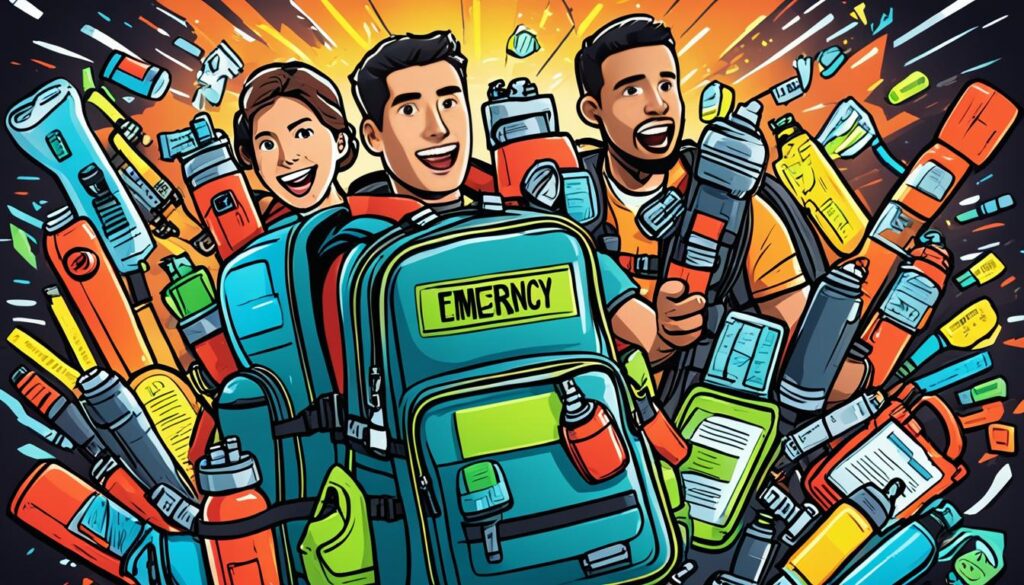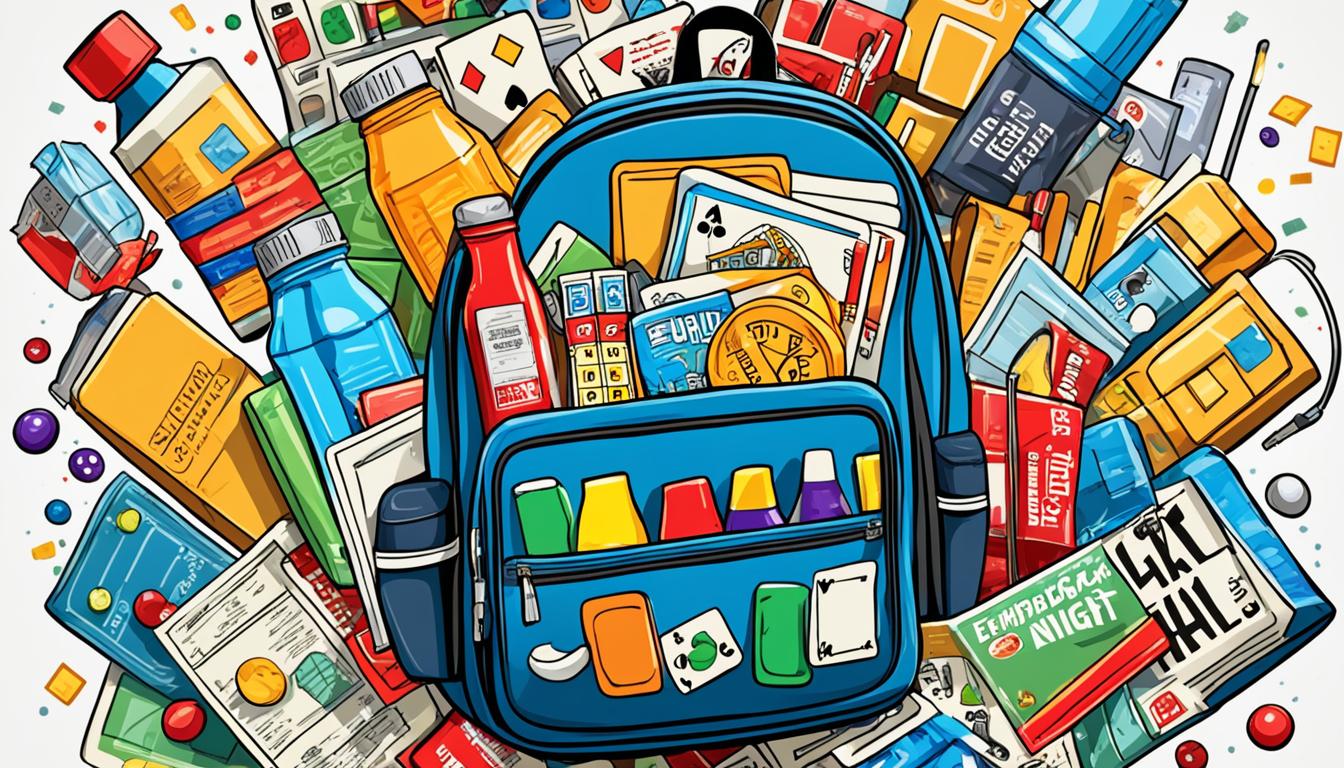Disclosure: This Post Contains Affiliate Links; We earn a commission on purchases.
When hosting a game night with friends and family, the last thing you want to think about is an emergency. However, being prepared for unexpected situations is essential for ensuring everyone’s safety and well-being. That’s why having an emergency kit specifically tailored for game night is crucial. With the right supplies on hand, you can handle any mishap that may arise and continue enjoying your evening of fun and games.
Key Takeaways:
- Creating an emergency kit for game night can provide peace of mind and ensure the safety of your guests.
- Include essential emergency supplies like water, food, communication tools, first aid items, and shelter necessities.
- Consider the specific needs of the individuals attending the game night when assembling your emergency kit.
- Be aware of the potential emergencies that could occur in your area and tailor your kit accordingly.
- Regularly review and update your emergency kit to ensure all items are in working order and not expired.
Table of Contents
Who is this kit for and what emergencies could affect me?
Before building an emergency kit, it is important to consider who the kit is for and the potential emergencies that could impact you. The kit’s contents may vary depending on the number of people and pets it needs to support and the specific needs of each individual. Additionally, the type of emergencies that are most likely to occur in your area should be taken into account. For example, if you live in an area prone to earthquakes, your kit should include earthquake-specific items such as sturdy shoes and a wrench to turn off utilities. By anticipating potential emergencies, you can better tailor your emergency kit to meet your specific needs.
“It’s essential to have a well-prepared emergency kit that is specifically designed for your household and the potential emergencies that could occur in your area. By considering who the kit is for and analyzing the possible risks, you can ensure that you have all the necessary items to stay safe during a crisis.” – Emily Thompson, Disaster Preparedness Expert
When determining who the emergency kit is for, consider the following:
- Number of people in your household
- Special needs of individuals, such as medical conditions or dietary restrictions
- Number and type of pets
In addition to personal factors, it is important to understand the potential emergencies that could impact your area:
- Research common natural disasters in your region, such as hurricanes, floods, or wildfires.
- Consider any man-made emergencies that are prevalent in your area, such as power outages, chemical spills, or civil unrest.
- Consult with local emergency management agencies or organizations to gain further insight into the specific risks in your community.
Once you have a clear understanding of who the emergency kit is for and the potential emergencies that could affect you, you can start creating an effective and personalized emergency kit. This will ensure that all essential items are included, providing you and your loved ones with the best possible protection and preparedness.
Stay Informed and Prepared
Knowing who the emergency kit is for and the potential emergencies that could affect you is the first step towards disaster preparedness. By tailoring your kit to address specific needs and risks, you can ensure that you have the necessary supplies and resources to stay safe during any crisis. Stay informed about local emergency preparedness guidelines and keep your emergency kit up to date.
Water: Staying Hydrated During an Emergency
Water is one of the most crucial emergency essentials to include in your preparedness kit. It is recommended to have at least one gallon of clean water per person per day for drinking and sanitation purposes. This ensures that you have an adequate supply to last for several days, giving you peace of mind during an emergency situation.
There are different ways to acquire the necessary water for your emergency kit. You can purchase gallons of purified water from the store, which are specifically designed for long-term storage. Alternatively, you can reuse empty bottles and fill them with tap water. Just make sure to replace the water every six months to keep it fresh.
If you’re creating a portable survival kit or need a lightweight option for on-the-go hydration, consider including a portable water filtering straw like the popular LifeStraw. This handy tool allows you to drink water directly from natural sources like rivers or lakes, filtering out harmful bacteria and parasites, ensuring that you can stay hydrated even when clean water sources are scarce.
Tips for Water Preparation:
- Purchase water containers: Choose durable containers specifically designed for storing water, ensuring they are BPA-free and have a sealable lid.
- Label and date: Clearly label each container with the date of storage and perform regular checks to ensure water freshness.
- Consider filtration systems: Invest in a water filtration system that can remove impurities and ensure a clean and safe water supply.
Water Supply Calculator:
To determine how much water you need to store, consider the number of people in your household and the recommended daily water intake per person. Use the table below as a guideline:
| Number of People | Water Needed (Gallons) |
|---|---|
| 1 | 1-2 |
| 2 | 2-4 |
| 3 | 3-6 |
| 4 | 4-8 |
| 5 | 5-10 |
Note: These amounts are general recommendations. Adjust the water supply based on individual needs and take into account factors like climate, physical activity, and medical conditions.
Remember, having an ample supply of clean water is essential for survival during an emergency. By including water in your emergency kit, you are taking a crucial step towards being fully prepared for any situation that may arise.
Food: Stocking up on essential nourishment
In an emergency, access to food may be limited. It is important to include non-perishable food items in your emergency kit that are easy to eat and provide essential nutrients. Consider including items like energy bars, beef jerky, nuts, dried fruit, and canned goods. It is also important to include food for babies and pets if needed. Rotate your emergency food supply every six months to ensure freshness and check expiration dates regularly.
Non-Perishable Food Items for Your Emergency Kit
| Food Item | Benefits |
|---|---|
| Energy bars | Provides quick energy and nutrition |
| Beef jerky | High in protein and shelf-stable |
| Nuts | Good source of healthy fats and protein |
| Dried fruit | Provides natural sweetness and vitamins |
| Canned goods | Long shelf life and easy to prepare |
By including a variety of non-perishable food items in your emergency kit, you can ensure that you have nourishing options available even in challenging circumstances. Don’t forget to consider any specific dietary needs and preferences when stocking up on emergency food supplies.
Communication and Light: Staying connected and visible
During an emergency, reliable communication and lighting are crucial for the safety and well-being of everyone involved. Including the right emergency gear in your kit can ensure that you stay connected and visible, even in challenging situations.
Communication Essentials:
Include a battery-powered or hand-crank radio in your emergency kit to receive updates on the situation and any safety risks. This will help you stay informed and make informed decisions based on accurate information. Additionally, pack a flashlight with extra batteries to navigate in the dark and illuminate your surroundings.
Showcasing Emergency Communication Gear Recommendations:
| Emergency Gear | Description | Price |
|---|---|---|
 | Battery-powered or hand-crank radio | $19.99 |
 | Flashlight with extra batteries | $12.99 |
By including these essential communication tools in your emergency kit, you can receive updates, stay connected with others, and navigate safely even in low-light conditions.
Visibility and Signaling:
During emergencies, it’s important to have tools that can help you attract attention if you are stranded and in need of assistance. Consider including a whistle in your emergency kit. This simple yet effective tool can help you alert others and signal for help.
Remember, it’s vital to test and ensure all communication and lighting gear is functioning properly before adding them to your emergency kit. Regularly check and replace batteries to maintain optimal performance.
First Aid: Being prepared for injuries
In any emergency, having a well-stocked first aid kit is crucial to provide immediate care and prevent further harm. Your first aid kit should include a range of essential items to handle different types of injuries and emergencies.
Here are some key items to include in your emergency first aid kit:
- Bandages: Adhesive bandages, sterile gauze pads, and adhesive tape for wound dressing and protection.
- Antibiotic ointment: To prevent infection in minor cuts, scrapes, or burns.
- Pain medications: Over-the-counter pain relievers like acetaminophen or ibuprofen for pain management.
- Prescription medications: If you or anyone in your household takes prescription medications regularly, keep a supply in your first aid kit.
- Burn cream: A specialized cream or gel to soothe and treat burns.
- Elastic bandages: To provide support and compression for sprains or strains.
- Allergy medicine: Antihistamines or other allergy medications, in case of allergic reactions.
- Tourniquets: In extreme situations, a tourniquet can be used to control severe bleeding.
It is essential to label all items clearly and keep them organized in waterproof containers to ensure their effectiveness during an emergency. Regularly check expiration dates and replace any expired or used items to maintain the kit’s readiness.
Having a properly stocked and readily accessible first aid kit can make a significant difference in providing immediate care and saving lives during an emergency.
Shelter and Clothing: Staying warm and protected
Having proper shelter and clothing is crucial during an emergency. By including the right items in your emergency kit, you can ensure that you and your loved ones stay warm and protected. Here are some essential items to consider:
1. Extra Sets of Clothes
Including extra sets of clothes in your emergency kit is important, as it allows you to stay dry and comfortable during uncertain times. Pack clothes that are appropriate for the season and consider including extra layers for added warmth. Remember to include spare socks, underwear, and sturdy shoes that are suitable for walking long distances if necessary.
2. Reflective Emergency Blankets
Reflective emergency blankets are lightweight and compact, making them a valuable addition to your emergency kit. These blankets are designed to retain body heat and provide insulation, helping to prevent hypothermia in cold conditions. They are also highly visible, making them useful for signaling for help.
3. Waterproof Tarp
A waterproof tarp can provide an additional layer of protection against the elements. It can be used to create a makeshift shelter or as a ground cover to keep you dry. Look for a durable and waterproof tarp that is large enough to provide adequate coverage for you and your family.
4. Paracord
Paracord is a versatile and strong cord that can be used to create shelters, secure tarps, or build emergency tools. It is lightweight and takes up little space in your kit but can be an invaluable resource in emergency situations. Consider including a length of paracord in your kit to enhance your shelter options.
5. Comfortable Shoes and Sturdy Gloves
During an emergency, you may need to evacuate or perform manual tasks that require durable footwear and hand protection. Include a pair of comfortable and sturdy shoes that can withstand rough terrain and provide support during long walks. Sturdy gloves will protect your hands and make it easier to handle debris or perform tasks that may require manual labor.
Remember to regularly review and update your emergency kit, ensuring that all clothing and shelter items are in good condition and suitable for the current season. By being prepared with the right shelter and clothing essentials, you can face emergencies with greater confidence and comfort.
| Essential Shelter and Clothing Items | Description |
|---|---|
| Extra Sets of Clothes | Pack extra clothes suitable for the season, including spare socks, underwear, and sturdy shoes. |
| Reflective Emergency Blankets | Lightweight and insulating blankets that retain body heat and provide visibility. |
| Waterproof Tarp | Durable and waterproof tarp for creating shelters or providing ground cover. |
| Paracord | Versatile and strong cord for building shelters and securing emergency tools. |
| Comfortable Shoes and Sturdy Gloves | Durable footwear and hand protection for evacuation or manual tasks. |
Comfort and Cleanliness: Keeping spirits high
During an emergency, it’s essential to prioritize comfort and cleanliness to maintain a sense of normalcy and keep spirits high. Alongside emergency supplies and essentials, including items that promote relaxation and personal hygiene in your emergency kit is crucial.
Entertainment for Power Outages
Power outages can be challenging, especially if they last for an extended period. Including books, games, puzzles, or other activities in your emergency kit can provide entertainment and help pass the time. These items can be a great distraction, particularly for families with children. Whether it’s reading a favorite novel, solving a crossword puzzle, or enjoying a board game, these activities can bring joy and help maintain a positive atmosphere while waiting for power to be restored.
Personal Hygiene Products
Personal hygiene is vital even during an emergency. Including items such as soap, hand sanitizer, and feminine care products in your emergency kit can help maintain cleanliness and prevent the spread of germs. These essentials ensure that you can maintain personal hygiene even when regular facilities are not available. Don’t forget to regularly check and replace these items to ensure they are fresh and effective.
Comfort for Children
If you have children, it’s important to consider their specific needs when preparing your emergency kit. Alongside regular food and water supplies, include extra items like diapers and baby food to ensure their comfort during an emergency. Additionally, packing their favorite toy or blanket can provide them with a sense of security and familiarity in a distressing situation.
| Comfort and Cleanliness Items for an Emergency Kit |
|---|
| Books |
| Games |
| Puzzles |
| Soap |
| Hand sanitizer |
| Feminine care products |
| Extra supplies for children (diapers, baby food) |
By including comfort and cleanliness items in your emergency kit, you can help alleviate stress and promote a sense of normalcy during challenging times. Remember to regularly check and replace these items to ensure they are up-to-date and in good condition.

Essential Tools: Being prepared for utility management
In the event of an emergency, having the right tools for utility management is essential. When disaster strikes, you may need to quickly turn off gas or water lines to ensure the safety of yourself and your loved ones. Having the proper tools at your fingertips can make this process easier and safer.
One of the most important tools to include in your emergency kit is a wrench or pliers. These versatile tools will allow you to quickly shut off gas or water valves, preventing further damage or potential hazards. It is crucial to familiarize yourself with the location of utility shut-off valves in your home and understand how to operate them correctly. This knowledge will enable you to act swiftly and effectively during an emergency.
By including essential tools in your emergency kit, you can confidently navigate utility management tasks during a crisis. Remember, preparedness is the key to staying safe and secure.
| Essential Tools for Utility Management |
| — |
| Wrench or pliers |
| Utility shut-off valve map or schematic |
| Duct tape |
| Gloves |
| Flashlight |
Conclusion
Being prepared for emergencies is essential, even during a fun activity like game night. By having an emergency kit on hand, you can ensure the safety and well-being of you and your guests.
Customize your emergency kit based on the specific needs of your household and the potential emergencies in your area. Regularly review and update your kit to ensure all items are in working order and not expired. With a well-prepared emergency kit, you can have peace of mind knowing that you are game-ready and disaster-prep smart.

As the founder of Friends Game Night, Ryan channels his enthusiasm for gaming into a platform that celebrates the magic of gathering friends around the digital or physical tabletop. Through his website, Ryan shares insightful articles, reviews, and recommendations, aiming to inspire others to create their own memorable gaming moments.
Subscribe to Our Newsletter








